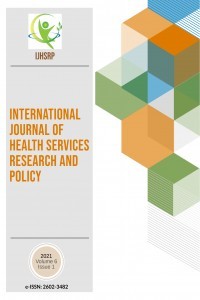FOSTER PARENT’S MOTIVATIONS REGARDING FOSTER CARE: A CROSS-SECTIONAL STUDY FROM SOUTH INDIA
FOSTER PARENT’S MOTIVATIONS REGARDING FOSTER CARE: A CROSS-SECTIONAL STUDY FROM SOUTH INDIA
Foster care, perceptions, motivations, foster parent,
___
- De Maeyer, S., Vanderfaeillie, J., Vanschoonlandt, F., Robberechts, M., Van Holen, F. (2014). Motivation for Foster Care. Children and Youth Services Review, 36,143–149.
- Tyebjee, T. (2003). Attitude, interest and motivation for adoption and foster care. Child Welfare, 82,685–706.
- Broady, T., Stoyles, G., McMullan, K., Caputi, P., Crittenden, N. (2010). The experiment of foster care. Journal of Child and Family Studies,19,559–571.
- Rodger, S., Cummings, A., Leschied, A. (2006). Who is caring for our most vulnerable children? The motivation to foster in child welfare. Child Abuse and Neglect,30,1129–1142.
- Zhang, Y. & Wildemuth, B.M. (2005). Qualitative analysis of content. Analysis, 1(2), 1-12.
- Ramirez, A. (2001). Understanding your motivation as a foster parent. Jordan Institute of families, 2,1.
- Borratta, E.F. & Montgomery, R.J.V. (2000). Encyclopedia of Sociology (2nd ed ). Pp. 1394. New York , Macmillan, p.144.
- Cox, M.E., Orme, J.G., Rhodes, K.W. (2003). Willingness to foster children with emotional or behavioral problems. Journal of Social Service Research, 29(4),23– 51.
- Rhodes, K., Cox, E., Orme, J., Coakley, T. (2006). Foster parents’ reason for fostering and foster family utilization. Journal of Sociology and Social Welfare, 33,105–126.
- Cole, S.A. (2005). Foster caregiver motivation and infant attachment: How do reasons for fostering affect relationships. Child and Adolescent Social Work Journal, 22,441–457.
- Batson, C.D. (1990). How social an animal? The human capacity for caring. American Psychologist, 45, 336-346.
- Batson, C.D. (1991). The altruism question: Toward a social psychological answer. Hillsdale, NJ, Erlbaum.
- Rosenhan, D. (1978). Toward resolving the altruism paradox: affect, self- reinforcement, and cognition. In: Wispe, L. (Eds. ) Altruism, sympathy, and helping: psychological and sociological principles. New York: Academic Press, 101-113.
- .Upshaw, M.B., Kaiser, C.R, Sommerville, J.A. (2015). Parent’s empathic perspective taking and altruistic behavior predicts infants’ arousal to others emotions. Front Psychol, 6,360.
- MacDonald, G & Leary, M.R. (2005). Why does social exclusion hurt? The relationship between social and physical pain. Psychological Bulletin, 131,202-223.
- Rushton, J.P., Fulker, D.W., Neale, M.C., Nias, D.K.B., Eysenck, H.J. (1989). Ageing and the relation of aggression, altruism and assertiveness scale t o t h e Eysenck personality Questionnaire. Personality and Individual Difference,10(2), 261-263.
- Einolf, C.J. (2011). The link between religion and helping others: the role of values, ideas, and language. Sociology of religion,72 (4),435-455.
- Amato, P.R. (1993). Urban-rural differences in helping friends and family members. Social psychology Quaterly, 56 (4), 249.
- Yayın Aralığı: Yılda 3 Sayı
- Başlangıç: 2016
- Yayıncı: Rojan GÜMÜŞ
Ebru GOKALP-OZKORKMAZ, Nursel GUL, Yusuf OZAY, Sevda GUZEL, Ahmet KAHRAMAN, Hakan ESKIZENGIN
CANCER RISK FACTORS AND PREVENTION IN TURKEY
Emine KAPLAN SERİN, Ahmet OZDEMIR, Mumin SAVAS
Fatma Başar, Seher Şeyma Hürata
CHANGABLE ENVIRONMENTAL RISK FACTORS IN AUTISM: VITAMIN D AND FOLIC ACID
FOSTER PARENT’S MOTIVATIONS REGARDING FOSTER CARE: A CROSS-SECTIONAL STUDY FROM SOUTH INDIA
Kurian JOSE, Benil HAFEEQ, Sheeba MUMTAZ, P.j. ANJALİ, N.a. UVAİS
INTERESTS AND OPİNİONS OF THE SOCİETY ON HEALTH NEWS AND PROGRAMS: A SAMPLE STUDY İN TRABZON
Sedat BOSTAN, Beyler YETKİNER, Tuğba ÇOLAK
Evaluation of Diastolic Dysfunction in Rheumatoid Arthritis Patients
Özge Turgay Yıldırım, Emel Gönüllü, Fatih Aydın, Ercan Akşit, Ayşe Hüseyinoğlu Aydın, Evrin Dağtekin
